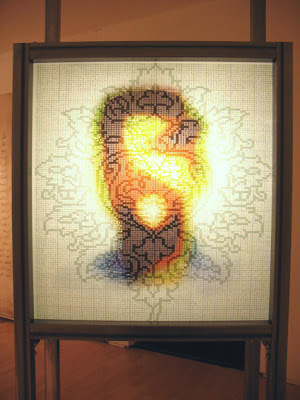 ALERT: Saturday, May 26th, is the second and FINAL day of this show. The exhibit will be open from 1:00 to 5:00 pm. The music performance starts at 3:00 pm sharp.
ALERT: Saturday, May 26th, is the second and FINAL day of this show. The exhibit will be open from 1:00 to 5:00 pm. The music performance starts at 3:00 pm sharp.The Artist in Residence program at the San Francisco Dump hit a peak this weekend with an exhibit of sculpture by artist Ellen Babcock and performances of a musical work by composer Nathaniel Stookey. In accord with the recycling premise of the program, Babcock and Stookey created their works using materials that ended up at the dump.
Stookey created a short three-movement composition for a battery of sound-makers including, pipes, the spokes of a bicycle, oil drums, a car bumper, metal trays, and many other objects. This intricate but zesty piece was well performed by the percussion section of the SF Symphony Youth Orchestra, joined by a musician who plays the saw. Even the children in the audience paid rapt attention.
The sculptures in Babcock’s exhibit are the happy result of explorations she began a couple of years ago. What started out as a fairly literal simulation of smallish rock specimens has now evolved into a far more complex game that has an assertive scale. I have not yet decoded the results in much depth, but will report my initial impressions. In addition to her rocks and crystals, Babcock has created simulations, I gather, of artworks from a traditional museum. Many of these objects look destroyed. They seem to have passed through a cataclysm that has given them a new type of expressiveness. Babcock has worked with mundane materials for a long time, but the materials used in this show are a step down. In this abject context, Styrofoam seems like a snooty material. Paradoxically, this plunge has released a surge of creativity. I found the work perversely exhilarating.
See above and below for images of several sculptures in the show.
The SF Dump is a short drive from the center of San Francisco. For directions, consult the SF Dump's Artist in Residence website.





























































